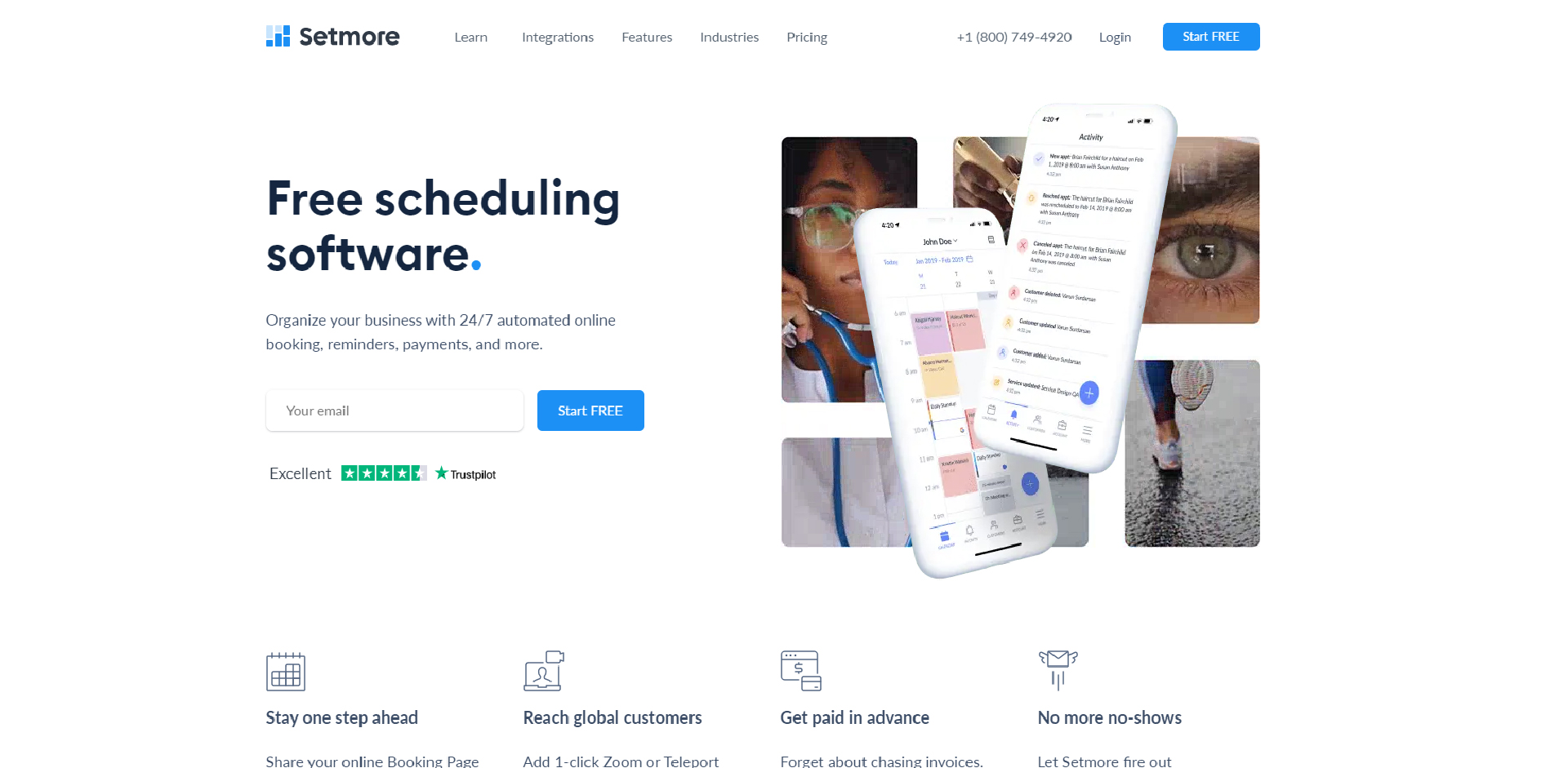
There’s nothing more rewarding than being your own boss and knowing that your business’s growth potential is unlimited. If you’re a personal trainer, starting your own at-home personal training business can be a dream come true, but that doesn’t mean it won’t be challenging.
Boost Your Client Retention with Trainerfu– Start Now!
Engage clients better and improve retention with Trainerfu’s features.
Try it freeOn one hand you get to execute your own vision, pick your own clients, have your own style of training, create a flexible schedule, and work from home!
On the other hand, not all of your many responsibilities will be fun ones, and you’ll be spending plenty of time doing things other than training, like administrative tasks. You’ll also be responsible for bringing in your own clients, which can feel like a full time job in itself!
But don’t worry. With a little motivation and perseverance you can reap the rewards of your hard work and build an incredibly successful personal training business right from your own home, and we’re going to help you get started.
Table of Contents:
- Chapter 1: Essentials For Starting Your Home Personal Training Business
- Chapter 2: Marketing Your Fitness Business
- Chapter 3: How To Reduce The Administrative Workload?
- Chapter 4: To Sum It All Up
Essentials For Starting Your Home Personal Training Business
You’re probably already dreaming of all the clients you will help and the amazing before and after photos you’ll be sharing with the world!
But before all that, you first have to set your business up on the backend. This means taking care of all the logistical necessities and setting yourself up for success.
Make your business legal
To make your business legal, you will need to register as a Limited Liability Company (LLC) or other official entity beyond sole proprietor. This typically can be done online through your local government. The fees for registering your business will likely range from a one-time payment of $50-$100 with some states requiring much smaller renewal fees each year.
Registering for an LLC can give your small business more credibility, provide liability protection, and offer more flexibility when tax time comes.
In addition, you will want to obtain a business license which will legally give you permission to run your business from home and is necessary for some business bank accounts. Check your local laws for other business-related requirements, like zoning approval for working with clients in your residence.
Get the right insurance
Locking down the right insurance is another big item to check off your small business to-do list. This is important for all businesses, but especially so for personal trainers since there is a risk of injury with fitness.
Insurance is all about protecting yourself from worst case scenarios, and having the right insurance in place can cover you if a client happens to get hurt during your training.
Plus, some states require personal trainers to have insurance to maintain their business licenses, so you’ll want to get this in place right away.
Build a versatile home gym
In addition to all the paperwork, you’ll also need to do some setting up of your actual training space. At-home personal trainers need a great, dedicated gym area loaded up with the right equipment.
Personal trainers will want to consider stocking their homes with equipment like: dumbbells, kettlebells, an adjustable bench, resistance bands, medicine balls, a rower, stationary bikes, workout mats, etc. Your needs will be dependent on the kind of training you are doing. Look for versatile pieces of equipment that serve multiple purposes (this is extra crucial if you’re working with a small space).
The design of your home gym is also important. Choose flooring that is supportive and can handle a lot of wear and tear. Opt for good, bright lighting and consider adding mirrors so you and clients can easily keep an eye of form. Proper heating and cooling ability is also a must – especially if you’re converting an outdoor space or garage into your new home gym.
Marketing Your Fitness Business
You’ve registered your business, picked a great business name, and set up a home gym worthy of a fitness pro. Now it’s time for the most important part – getting clients!
For many personal trainers, referrals from other clients are a great source of steady work. And if you’re coming from a gym or other fitness business, you may already have a great pipeline of clients to support your at-home personal training business.
However, no matter whether you have some existing clients or not, it’s important to make marketing your personal training business a priority. The right marketing strategy is the best way to attract new clients consistently so that your business can grow.
Decide on your niche
All marketing efforts take time and money. The best way to make sure that you are making the most of these precious resources is to only market to people that will give you the highest ROI on your marketing efforts, AKA your niche. Nail down your personal training niche and tailor all of your marketing content to that target audience.
If you aren’t clear on your niche for your personal training business, here are some tips to help:

1. Think about who your happiest clients are ; these are the people that understand the value of your service, have worked with you the longest, and are eager to share their positive experience. Are they busy women looking to lose weight? Or are they seniors looking to gain more strength and mobility? Which client have you been able to bring the best results?
If you’re just starting out, think about who you want to work with, and which segment of the population you think you are most qualified to help.
2. Make sure your niche is the right size . The important next step is making sure that those segments are the right size. For example, targeting “people that want to get in shape” might be a bit too broad. Whereas, “people with rotator cuff injuries” might be a little too narrow.
You’ve got to find the sweet spot, where the market is large enough to meet your revenue goals, but not so big that you aren’t able to tailor your marketing efforts accordingly.
3. Pick a niche that matches your passion and your skills. Lastly, an incredibly important part of niching down is making sure you are qualified to work within your niche and that you actually enjoy doing so. This part is especially vital because it determines how you will excel in your business and build your reputation. The passion for what you do will come in handy when things get tough, and your expertise/experience in a certain area makes you more qualified than others to serve your particular niche.
Determine what sets you apart
Marketing your business is all about attracting your ideal clients and showing them why you are better than the competition. To successfully do this, you have to get to know who your competition even is and what makes you different.
Your competition isn’t necessarily a personal trainer in another city. Your competition is a business your prospects will go to if you didn’t exist. This might be a local gym or studio or even online fitness classes.
Once you’re clear on who you’re competing with, list out the things that set you apart. What do you do differently? What makes you more qualified to serve people within your niche? Think about the unique benefit that your training provides to your ideal clients.
Build your personal brand
Branding is about the message you send, the story you tell, and the way people feel when interacting with your business. It includes all aspects of your business like logos and color choices, the tone of your online content, and your mission statement.
In simple words, your brand is how people would describe your business to their friends. It’s the personality element you give to your business.
Personal trainers can build a great fitness brand by thinking about the personality elements their ideal clients relate to. Share these parts of yourself online to build likability and get people to trust you.
Get leads
Once you have a razor sharp niche and a strategy for building your brand, it’s time to find some clients – or better yet, let them find you!
Online marketing can be a great way to reach potential clients and to open ongoing communication channels with them. We have some great online marketing resources for personal trainers. Consider starting here:
- The Ultimate Guide to Instagram Marketing for Personal Trainers
- Fitness Email Marketing: The Definitive Guide
- 30 Personal Trainer Marketing Tips to Skyrocket Your Fitness Business
And here are some quick ideas for finding leads:
- Run a promotion
- Run online ads
- Build partnerships
- Go door to door
- Go to events/meetups
- Host an event or seminar
Consider online personal training
Your marketing efforts will fall flat if you don’t have the right offers. Using your ideal clients as your guide, make sure to create training programs and packages that work best for them and help them reach their goals.
Think outside the traditional personal training model and consider offering online personal training. Fully online personal training or hybrid training involves delivering some or all of your personal training remotely.
This can be a great option for personal trainers that work from home and can make your training more accessible for a larger client base, because online personal training is more affordable and flexible for clients.
How To Reduce The Administrative Workload?
Small business owners are no strangers to mile long to-do lists and a seemingly never-ending amount of daily tasks. If you start your own at-home personal training business, you’ll quickly feel like you barely have time to do all the behind the scenes work, let alone train clients.
Luckily, for business owners everywhere, there are tools that can take on some of the work for you and make your life much easier.
If you’re just starting out, there’s no need to blow a fortune on software or spend hours teaching yourself fifteen new small business platforms. We’re going to give you our recommendations for what you need to reduce your administrative workload and feel a little more in control of your business.
Scheduling software
Scheduling software is crucial for personal trainers, as it allows clients to automatically book with you based on your availability. This can reduce overbooking, no shows, and save you a ton of time when it comes to running your business.
There are quite a few different scheduling software out there, but for at-home personal training businesses, Calendly or SetMore should do the trick.
Calendly focuses on making scheduling easier for you and your clients. With Calendly, you can set your availability and meeting types. You can decide how long your meeting windows are, how far in advance someone needs to book, and how much of a buffer you need between appointments.

Calendly produces a link to a calendar that you can integrate into your website or send directly to clients. They select a time that works for them and the meeting info is sent automatically to them. This works for both in-person and virtual meetings.
Calendly has a range of plans starting at a free option, going up to $16 per month (which is built for businesses with multiple team members). Most personal trainers can get by with the $12 per month plan which will allow you to access integration and customization features.
Like Calendly, SetMore makes scheduling appointments easy for your clients.
This site has a well designed interface and is fairly easy to use. SetMore lets you create different service options and even group classes. You can share your unique URL with your audience so that they can book within your availability.
SetMore allows for customization on your booking page. You can add cancellation policy and your business hours. You can even request reviews right in the platform (which make great content for your social media channels by the way!)

Their free plan is really robust, and allows you to take unlimited appointments, take online payments, and add up to four employees.
Accounting software
For many business owners, keeping up with finances is not the most fun part of running a business, however, it’s an absolute must. Fortunately, there are plenty of online tools that can help keep you organized and profitable and make tax time a breeze instead of a nightmare.
There are many small business accounting software for personal trainers to choose from.We broke them all down in this article: Best Accounting Software for Personal Trainers.
Wave can be a great accounting software to start with. It’s free other than small transaction fees for payment processing. Wave has great reporting features and allows you to create and send invoices. You can even integrate Wave with your website to directly take payments. You can also keep track of expenses in the software by manually uploading data from your receipts.
Online personal training software
Online personal training software helps you deliver your personal training to clients more seamlessly. It automates some of the tedious tasks within your business, helping you train more clients in less time.
When deciding on the software for you, it can be helpful to think about the following features:
- Workout planner
- Mobile app features
- Technology & user experience
- Community features
- Automation capabilities
- Custom branded app plan
- Ratings
- Pricing
When it comes to implementing these features with both client and trainer experience in mind, TrainerFu takes the cake.
TrainerFu has consolidated workout planning features that save you time and let you manage clients from a single dashboard. The app is also just as robust as the website, so that you can take advantage of all its features without being tied to a desk all day. Plus, TrainerFu has a number of automation features to save personal trainers time.
TrainerFu also stands out when it comes to community features and even has a Facebook like newsfeed where clients can communicate, share wins, and support each other.
TrainerFu can also help you build a recognizable fitness brand by offering custom branded app features. This ups your professionalism and can help you convert more clients.
Lastly, TrainerFu is highly rated, and competitively priced. You can even try it for free.
To Sum It All Up
Starting an at-home personal training business is not a quick and easy process. However, with passion and dedication, you can be highly successful and enjoy all the perks of being your own boss.
Set yourself up for success from the very beginning. Check all the legal boxes, and build a home gym that meets the needs of your clients. From there, you’re ready to start marketing your business online and attracting new clients.
Once the clients start rolling in, use the right tools to minimize your workload and keep training simple. You may even outsource some of your work eventually, but for now, an accounting software, scheduling tool, and online personal training platform are a great place to start.
Frequently Asked Questions
1. What are the key steps to starting a home personal training business?
Key steps include registering your business as an LLC, obtaining necessary licenses, securing insurance, and setting up a well-equipped and functional home gym.
2. Why is obtaining insurance essential for personal trainers?
Insurance protects trainers from liability in case of client injuries and may be legally required in some locations.
3. What are the advantages of offering online personal training?
Online training expands reach, offers flexibility, and complements traditional in-person sessions, making it easier to scale the business.
4. How important is branding for a personal training business?
Branding establishes trust and connection with clients by reflecting the trainer’s unique personality and value proposition.
